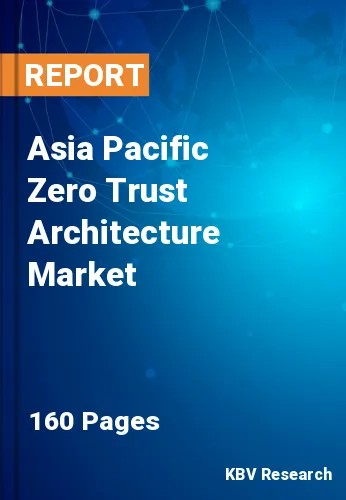The Asia Pacific Zero Trust Architecture Market would witness market growth of 16.9% CAGR during the forecast period (2023-2030).
The evolution of ZTA has been significantly influenced by innovation, as cybersecurity vendors and organizations have invested substantially in developing solutions that adhere to the tenets of least privilege access and continuous verification. The integration of cutting-edge technologies, including machine learning (ML) and artificial intelligence (AI), has facilitated the implementation of more sophisticated access controls and threat detection systems. These technologies empower ZTA to dynamically adjust security policies in real-time based on evolving risk factors.
The dynamic nature of modern IT environments has driven the development of ZTA. As organizations increasingly adopt cloud computing, mobile devices, and remote work, the traditional security perimeter has become porous and less defined. This shift has created new challenges for securing digital assets as the attack surface has expanded beyond the confines of the corporate network. ZTA provides a solution by treating every access attempt as potentially malicious, regardless of the user's location or the device's security posture.
Many Asia Pacific nations are experiencing accelerated digital transformation across industries. For example, the Government of India launched an ambitious project called "GI Cloud," also known as "Meghraj," to use and reap the advantages of cloud computing. several governments have undertaken broader cybersecurity initiatives that align with ZTA principles or emphasize the importance of adopting advanced security frameworks. For example, the Australian government has launched various initiatives, including the Australian Cyber Security Centre (ACSC) and the National Cyber Security Strategy, which advocate for stronger cybersecurity measures. Consequently, the convergence of these factors underscores the rising need for ZTA solutions across Asia Pacific nations, highlighting its relevance in addressing evolving cyber threats and supporting digital transformation.
The China market dominated the Asia Pacific Zero Trust Architecture Market, By Country in 2022, and would continue to be a dominant market till 2030; thereby, achieving a market value of $3.7 billion by 2030. The Japan market is registering a CAGR of 16.1% during (2023 - 2030). Additionally, The India market would showcase a CAGR of 17.6% during (2023 - 2030).
Based on Component, the market is segmented into Solution, and Services. Based on Organization Size, the market is segmented into Large Enterprises, and Small & Medium Enterprises. Based on Deployment Type, the market is segmented into On-premise, and Cloud. Based on Vertical, the market is segmented into IT & ITeS, Energy & Utilities, Healthcare, Government & Defense, Retail & Ecommerce, BFSI, and Others. Based on countries, the market is segmented into China, Japan, India, South Korea, Singapore, Malaysia, and Rest of Asia Pacific.
Free Valuable Insights: The Global Zero Trust Architecture Market is Predict to reach $49.6 Billion by 2030, at a CAGR of 15.8%
The market research report covers the analysis of key stake holders of the market. Key companies profiled in the report include Palo Alto Networks, Inc., VMware, Inc., Zscaler, Inc., Akamai Technologies, Inc., Microsoft Corporation, Cisco Systems, Inc., IBM Corporation, Citrix Systems, Inc. (Cloud Software Group, Inc.), Check Point Software Technologies Ltd. and Forcepoint LLC (Francisco Partners).
By Component
By Organization Size
By Deployment Type
By Vertical
By Country
Our team of dedicated experts can provide you with attractive expansion opportunities for your business.

